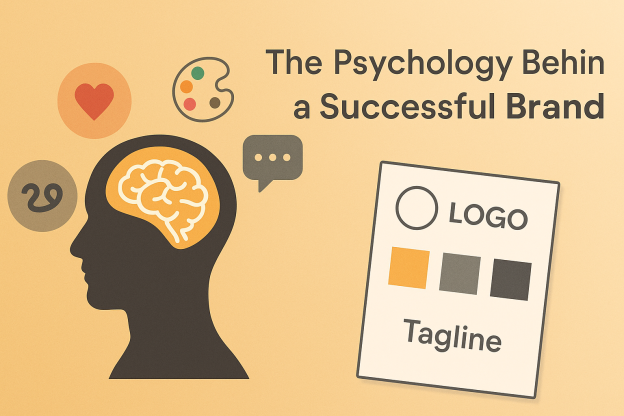The Psychology Behind a Successful Brand

How do brands come up with the themes of colours, pictures, wall paint, and everything associated with their name? That’s called building a brand using psychology. Entrepreneurs and business owners brainstorm themes, patterns, colours, messages and everything that is going to be associated with their name.
Branding is an ongoing process. You cannot be done with branding after announcing your brand’s name and services. Your marketing efforts will be in vain if branding is not done right. Branding takes a lot of effort and time. More than that, your brand’s name should evoke an emotional response in customers’ minds when they hear it. But how do business owners do that? They do it by leveraging psychology to build a brand identity. To put it in simple words, branding is how you communicate your USP, your products and services to people.
Psychology is everywhere. For instance, Schools paint the walls of kindergarten students in a certain colour to boost cognitive functions and build a positive mindset. In this article, we will explore how brands use psychology and what it takes to build a successful brand.
How Do Branding and Psychology Work Together?
Why do you love a Nike sneaker than an Adidas has more to do with your brain than your feet!
There is a crucial role of psychology in branding as it helps business owners understand the way their customers feel, think and make decisions. Business owners can understand which factors influence customer loyalty, brand perception, and their purchasing behaviour.
Successful brands use psychological concepts to foster meaningful connections with their target customers. The branding psychology principles include pattern recognition, colour psychology, in groups, and five brand personalities. Collectively, the psychological principles create a brand experience through which customers can resonate with the brand on a psychological level.
Psychology behind branding allows business owners to learn the way customers perceive and connect with the brand. Brands use strategies like creating cognitive bias to influence customers’ decision-making. It changes the way customers perceive brands.
Brands Create Perception Using Colours
Colour psychology is one of the important aspects in developing a brand. Through colour psychology, business owners can evoke different psychological and emotional responses in customers.
Some colours evoke a response having cultural influence, while other colours can be more universal. For example, green colour is associated with growth and nature, while the red colour highlights urgency, passion, and heat. Brands use specific colours to communicate their brand values, messages, USP values and price points to the customers.
Branding is not only about creating a catchy tagline or an appealing logo. Yes, a unique logo will make your brand memorable, but there’s more to it. Branding is the process of curating a unique identity that leaves a mark in a customer’s mind, especially on an emotional level. This is where brand psychology works. It bridges the gap between brands and customers. Psychology helps brands understand customers more on a human level. It helps them read human behaviour and create perceptions related to the brand.
Brands Capitalise on Anchor and Confirmation Bias
Brands use anchoring bias and confirmation bias to shape the decision-making of customers.
Anchoring Bias
In the anchoring bias, customers’ decisions rely heavily on the first encountered information about the product. Brands use this bias strategically to influence the way customers perceive the value and price of the product. They introduce higher-priced options to the customers initially. Later on, they guide the customers to see other options as more affordable and reasonable. It keeps the customers hooked on their platform while the brand drives conversion.
Confirmation Bias
In the confirmation bias, customers favour the information that already aligns with their existing beliefs. Brands strategically leverage confirmation bias and capitalise on it by consistently reinforcing positive associations through their marketing reviews, messages and social proofs. For example, customers already have a perception that almond milk is good for health. Brands capitalise on this bias by providing multiple reviews, testimonials and UGC (user-generated content) that confirms this bias for customers. Through this, brands drive customers to buy their almond milk products.
Branding Psychology Optimises Your Relationships with Customers
Successful branding is not about selling a service or a product to customers. It is about connecting with them on a deeper level.
The brands that deliver consistently positive experiences to customers foster stronger connections, encourage advocacy and drive even greater customer loyalty. The customers who feel valued and appreciated form even deeper loyalty to the brand. Hence, the brand loyalty psychology principles are crucial in fostering and maintaining robust customer relationships.
Business owners can tailor their strategies by understanding the factors driving brand loyalty to develop a lasting relationship with their audience. One such strategy is understanding customer experience (CX). Several companies and brands are working towards improving the overall customer experience for their audience, and it goes beyond the quality of service or the product.
Branding psychology helps businesses tailor the customer experience to their preferences and needs. Brands want customers to have a sense of value and belonging. To achieve this, they offer personalised recommendations, send personalised messages and emails. In addition, brands also take a follow-up by addressing customers by name through emails, WhatsApp popups, etc.
To Sum Up
It is important to have a strong brand identity in today’s competitive market. Brands work consistently towards acquiring a loyal customer base. Branding psychology helps immensely in gaining loyal customers and changing customer perception about the brand. There are a lot of factors at play in ‘successful branding’. Branding is not only about what product or service you are going to deliver. It is about evoking a unique psychological and emotional response in customers’ minds when they hear your brand name.
Your brand logo, primary colours, messaging, USP, products/services and even customer experience curate a brand identity. In this competitive environment, learn if your business needs a makeover. VerveBranding, a best logo design company in India, can assist you in branding, logo design and creating compelling graphics to help you connect with a wide audience. So what are you waiting for? Reach out to us now!




